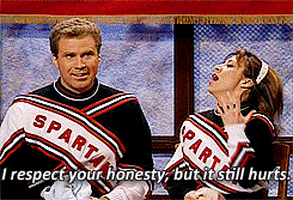Is there anything worse than submitting a piece of writing somewhere and getting it sent back with endless edits?
Opening a document filled with notes is like an instant gut-punch.
It says, “You didn’t nail this one.”
And while not nailing it on the first try is definitely okay--wouldn’t it be great if you could cut down on the edits required by, say, 50 percent? 30 percent, even? I’d sign up for that.
The good news is: It’s pretty easy to achieve this goal.
In working with some truly talented editors over the past several years who manage high traffic blogs and top-ranked publications, I’ve noticed four common themes within their editing processes.
Today, I use these approaches on my own writing before sending over a first draft. As a result, both parties spend significantly less time editing.
Sounds nice, right? Here's what you need to know.
1. Punch up your title and headings
The first time I turned in a post for CopyHackers, I noticed that when the edits came back, my title and all of the headings had been changed...and they were WAY BETTER.
As I was reading, I went, “Ohhhhhhhhhh...I get it now...”
The edited versions were more interesting, funnier, and did a better job of leading the reader further down into the post. Overall, these punched up elements made the whole piece more valuable.
Here’s an example...
My heading: Why emotion in advertising works
CH heading: You know we buy based on emotion and justify with logic. But do you know why?
Clearly, the CopyHackers version is much more interesting--and it’s formulated in a natural way that entices the reader to keep reading.
Today, I take this approach with all of my long-form writing.
In editing headings, I make sure that I’m posing questions, teasing out pain points, or setting up an interesting story that leverages a curiosity gap. You should do it, too.
2. Always ask, “But, why?”
The best editors I’ve worked with are great at spotting holes and asking, “But why?” to every point being made.
In order for your writing to be thorough and logical, it needs to answer any questions that naturally arise. If as you’re reading, you think, “Will my reader already know the backstory here?”--it’s safe to assume the answer is no.
That means: If there’s something left unexplained, take the time to spell it out for the reader.
Often times research and case studies are a good way to do this. Illustrate everything you can, add clarity around complex ideas, and back up every point with details.
It’s kind of like writing a college research paper. You should be adding to your annotated bibliography (man, I hated those…) all the way through the piece.
3. Break down long sentences
I have a tendency to ramble a bit with my sentences. I just like it, okay?
But most of the time, shorter, less complex sentences are much better for general reading comprehension. Plus, the shorter your sentences, the easier it is to break up big chunks of on-screen text. That means easier reading.
Free tools like Hemingway App can help you spot your overly complex sentences, but keep in mind that you don’t need to super-simplify, either. It’s a good rule of thumb to strive for a 10th grade reading level.
4. Reorganize the non-sequiturs
Especially if you’re writing anything long-form, it can be easy to get ahead of yourself and to introduce new ideas or points that don’t flow naturally within the piece. But that’s non-sequitur (and not so good).
Your goal as a writer is to put together points that build upon one another--so when there’s information introduced that falls out of line with what you’re building, it makes the whole structure...kinda shaky.
That’s why you need to make sure you’re building a pyramid shape with your writing, not an asterisk.
Now, if you’re too “inside” the piece to accurately judge the flow, then you should get a second set of eyes to read it for you.
This doesn’t need to be someone who intimately knows the subject matter, either. It can actually be a benefit to have an outsider review what you’ve written, as they can more easily spot areas where greater clarity or explanation is needed.
And remember…
While these are the big four as far as most helpful takeaways I’ve gleaned from working with various editors, you should also keep a few things top-of-mind while you edit:
The better you get at self-editing, the more editors will appreciate working with you (and the more readers will enjoy reading your stuff).
This article originally appeared in my newsletter, A Cup of Copy. Sign up and get these free tips sent right to your inbox every other Wednesday.
